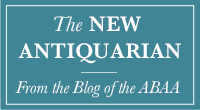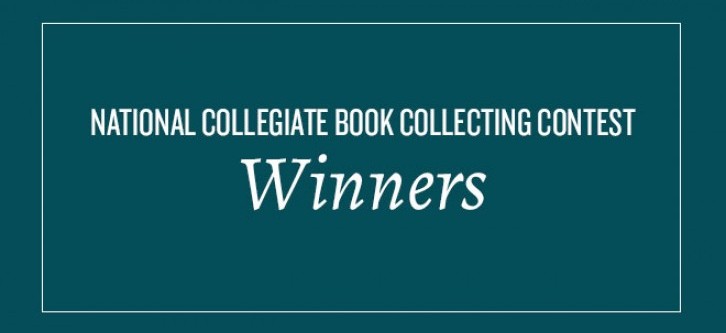The National Collegiate Book Collecting Contest awards ceremony was held at the Library of Congress on September 13, 2024. The Contest was established in 2005 by Fine Books & Collections Magazine to recognize outstanding book collecting efforts by college and university students--the program aims to encourage young collectors to become accomplished bibliophiles. ABAA Member and collector Rebecca Romney was the featured speaker and made the winners and guests feel welcome.
The Antiquarian Booksellers' Association of America (ABAA), the Fellowship of American Bibliophilic Societies (FABS), and the Center for the Book and the Rare Books and Special Collections Division (the Library of Congress) jointly assumed leadership of the National Collegiate Book Collecting Contest in 2010. The Grolier Club, a noted book collectors organization, joined us shortly afterward. Incidentally, each winner has a year-long membership at the Grolier Club in New York City. We thank this year’s judges who are part of these partner organizations: Shannon Struble, Jennifer Larson, and Sharon Gee; Sheryl Jaeger, Declan Kiely, Olivia Loksing Moy, and Nancy Boehm who are each collectors and bibliophiles in their own right. Incidentally, each winner has a year-long membership at the Grolier Club in New York City. We also thank Susan Jaffe Tane, the noted collector and philanthropist, for nurturing the next generation of collectors. Prizes are awarded to both the winning students and the libraries of the prize winners. We extend our congratulations to Georgetown University and Princeton University.
The Second Prize Winner is Dennis Schäfer of Princeton University for "Charting the Visual Universes of E.T.A. Hoffmann Illustrators". Dennis’s interest in Hoffman was initially academic in nature, but this soon blossomed into a passion after he received a beautifully illustrated edition of Hoffmann’s The Golden Pot upon joining the E.T.A.-Hoffmann-Society.
The First Prize Winner is Amanda Zhao of Georgetown University for "War’s Little People". Amanda’s sponsor notes he was particularly impressed with her focus on exploring WWII history with an eye towards the effects of the war civilians and an ultimate the goal of expanding her knowledge and writing a novel. Both winners shared some insights into their interests and collections with the New Antiquarian.
First Prize
Amanda Zhao (Georgetown University), "War’s Little People."
Zhao’s sponsor notes he was particularly impressed with her focus on exploring WWII history with an eye towards the effects of the war civilians and an ultimate the goal of expanding her own knowledge and writing a novel.
Could you give us a brief description of your collection?
AZ: My collection consists of war histories and memoirs written by those who have experienced warfare, with a focus on WW2 in Europe. Most of the books are histories about the conflict in specific regions (e.g. USSR/ Eastern Front) or specific components of the German war machine (e.g. Foreign Ministry). While searching for additions to my collection, I look for books covering aspects of the war I do not have or reputable authors.
What first interested you in the effects of war on non-combatants?
AZ: I’m not necessarily interested in the effects of war on non-combatants, but on human beings in general. I’ve been interested in this concept since 4th grade, when WW2 and the Holocaust was first taught in school, and have grown more knowledgeable on similar events due to the internet and reading. War is possibly the greatest psychological and philosophical experiment ever created by mankind— if only we could decipher what it is trying to say. My dream is to write an epic novel— in the vein of Tolstoy or Wouk— where the war is the main character as opposed to a setting.
What currently has pride of place in the collection?
AZ: Revolt in the Desert by T.E. Lawrence is the pride of my collection. I fell in love with the character of Lawrence — possibly the greatest representation of the complexities of human nature in war — on the silver screen. To sum things up, my fascination with Lawrence led me on a quest to own his memoir. However, my book is unique because the previous owner would cut out news clippings and stick them between related pages, which include unique photos of Lawrence and the Hashemite Family.
Second Prize
Dennis Schäfer (Princeton University), "Charting the Visual Universes of E.T.A. Hoffmann Illustrators."
Schäfer’s interest in Hoffman was initially academic in nature, but this soon blossomed into a passion after he received a beautifully illustrated edition of Hoffmann’s The Golden Pot upon joining the E.T.A.-Hoffmann-Society.
Could you give us a brief description of your collection?
DS: I collect illustrated editions of literary works by E.T.A. Hoffmann (1776-1822), a German Romantic author, caricaturist, jurist and musician. I own various illustrated editions of his work, mostly from the 20th century, and I am currently seeking to expand my portfolio with 19th century editions, limited editions of variegated provenance, and other visual materials like prints, postcards, or graphic novels.
What first interested you in E.T.A. Hoffman and more specifically those who illustrated his work?
DS: The interest initially grew out of my scholarly engagement with Hoffmann, but has since then expanded considerably. Hoffmann’s reception across various media has been abiding, productive, and transnational. There are always new illustrated editions to discover which renders collecting Hoffmann, even with a specific focus on illustrations, an ongoing treasure hunt. The amount of English-language editions of the Nutcracker alone is staggering! What interests me is the interesting conflux of mass-market appeal that these illustrations have and Hoffmann's appreciation by bibliophiles, who consistently turn to Hoffmann for high caliber limited editions. As a collector, I do not see a disparity between these two impulses; every one of these aesthetic interventions has the ability to mesmerize me anew and reminds me of the many ways in which we can express and appreciate the beauty of the book.
What currently has pride of place in your collection?
DS: There are three items, that are very recent acquisitions, which I am very proud about: The first would be a 1943 edition of E.T.A. Hoffmann’s Tales done by the Limited Editions Club from New York, with hauntingly uncanny illustrations by Hugo Steiner-Prag. My edition is #411 of 1.500!
The second is an edition of Klein Zaches, genannt Zinnober (Little Zaches, called Zinnober), illustrated by Steffen Faust and published by Serapion am See. Serapion am See was a small German publishing house in Berlin in the early 2000s that made illustrated Hoffmann texts with a low number of impressions for bibliophiles. In the coming years, it is my goal to assemble their entire portfolio.
The third item is a set of E.T.A. Hoffmann stamps that were issued by the West German postal service on the 150th anniversary of his death in 1972. It was an interesting foray into philately and showed me interesting ways in which my collection, in the future, can ultimately move beyond books towards other artistic engagements with Hoffmann’s work.
The National Collegiate Book Collecting Contest is jointly administered by the Antiquarian Booksellers' Association of America (ABAA), the Fellowship of American Bibliophilic Societies (FABS), and the Grolier Club, and is supported by the Rare Books and Special Collections Division (the Library of Congress). Noted collector, bibliophile, and philanthropist Susan Jaffe Tane funds the prizes for the National Collegiate Book Collecting Contest. The prize is known as The Susan Tane Prize for Student Book Collectors.


